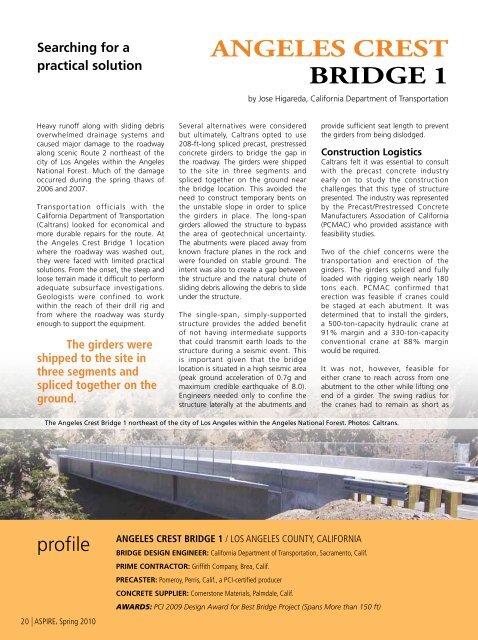ASPIRE Spring 10 - Aspire - The Concrete Bridge Magazine
ASPIRE Spring 10 - Aspire - The Concrete Bridge Magazine
ASPIRE Spring 10 - Aspire - The Concrete Bridge Magazine
You also want an ePaper? Increase the reach of your titles
YUMPU automatically turns print PDFs into web optimized ePapers that Google loves.
Searching for a<br />
practical solution<br />
Angeles Crest<br />
<strong>Bridge</strong> 1<br />
by Jose Higareda, California Department of Transportation<br />
Heavy runoff along with sliding debris<br />
overwhelmed drainage systems and<br />
caused major damage to the roadway<br />
along scenic Route 2 northeast of the<br />
city of Los Angeles within the Angeles<br />
National Forest. Much of the damage<br />
occurred during the spring thaws of<br />
2006 and 2007.<br />
Transportation officials with the<br />
California Department of Transportation<br />
(Caltrans) looked for economical and<br />
more durable repairs for the route. At<br />
the Angeles Crest <strong>Bridge</strong> 1 location<br />
where the roadway was washed out,<br />
they were faced with limited practical<br />
solutions. From the onset, the steep and<br />
loose terrain made it difficult to perform<br />
adequate subsurface investigations.<br />
Geologists were confined to work<br />
within the reach of their drill rig and<br />
from where the roadway was sturdy<br />
enough to support the equipment.<br />
<strong>The</strong> girders were<br />
shipped to the site in<br />
three segments and<br />
spliced together on the<br />
ground.<br />
Several alternatives were considered<br />
but ultimately, Caltrans opted to use<br />
208-ft-long spliced precast, prestressed<br />
concrete girders to bridge the gap in<br />
the roadway. <strong>The</strong> girders were shipped<br />
to the site in three segments and<br />
spliced together on the ground near<br />
the bridge location. This avoided the<br />
need to construct temporary bents on<br />
the unstable slope in order to splice<br />
the girders in place. <strong>The</strong> long-span<br />
girders allowed the structure to bypass<br />
the area of geotechnical uncertainty.<br />
<strong>The</strong> abutments were placed away from<br />
known fracture planes in the rock and<br />
were founded on stable ground. <strong>The</strong><br />
intent was also to create a gap between<br />
the structure and the natural chute of<br />
sliding debris allowing the debris to slide<br />
under the structure.<br />
<strong>The</strong> single-span, simply-supported<br />
structure provides the added benefit<br />
of not having intermediate supports<br />
that could transmit earth loads to the<br />
structure during a seismic event. This<br />
is important given that the bridge<br />
location is situated in a high seismic area<br />
(peak ground acceleration of 0.7g and<br />
maximum credible earthquake of 8.0).<br />
Engineers needed only to confine the<br />
structure laterally at the abutments and<br />
provide sufficient seat length to prevent<br />
the girders from being dislodged.<br />
Construction Logistics<br />
Caltrans felt it was essential to consult<br />
with the precast concrete industry<br />
early on to study the construction<br />
challenges that this type of structure<br />
presented. <strong>The</strong> industry was represented<br />
by the Precast/Prestressed <strong>Concrete</strong><br />
Manufacturers Association of California<br />
(PCMAC) who provided assistance with<br />
feasibility studies.<br />
Two of the chief concerns were the<br />
transportation and erection of the<br />
girders. <strong>The</strong> girders spliced and fully<br />
loaded with rigging weigh nearly 180<br />
tons each. PCMAC confirmed that<br />
erection was feasible if cranes could<br />
be staged at each abutment. It was<br />
determined that to install the girders,<br />
a 500-ton-capacity hydraulic crane at<br />
91% margin and a 330-ton-capacity<br />
conventional crane at 88% margin<br />
would be required.<br />
It was not, however, feasible for<br />
either crane to reach across from one<br />
abutment to the other while lifting one<br />
end of a girder. <strong>The</strong> swing radius for<br />
the cranes had to remain as short as<br />
<strong>The</strong> Angeles Crest <strong>Bridge</strong> 1 northeast of the city of Los Angeles within the Angeles National Forest. Photos: Caltrans.<br />
profile<br />
20 | <strong>ASPIRE</strong>, <strong>Spring</strong> 20<strong>10</strong><br />
ANGELES CREST BRIDGE 1 / LOS ANGELES COUNTY, CALIFORNIA<br />
<strong>Bridge</strong> Design Engineer: California Department of Transportation, Sacramento, Calif.<br />
Prime Contractor: Griffith Company, Brea, Calif.<br />
Precaster: Pomeroy, Perris, Calif., a PCI-certified producer<br />
<strong>Concrete</strong> Supplier: Cornerstone Materials, Palmdale, Calif.<br />
awards: PCI 2009 Design Award for Best <strong>Bridge</strong> Project (Spans More than 150 ft)

















